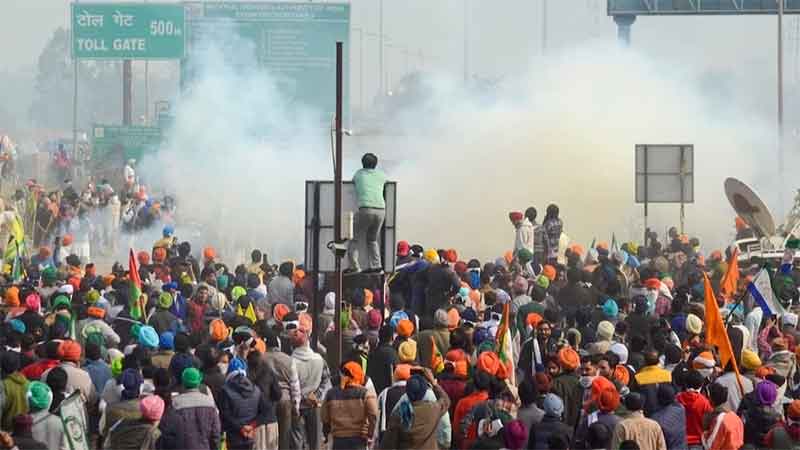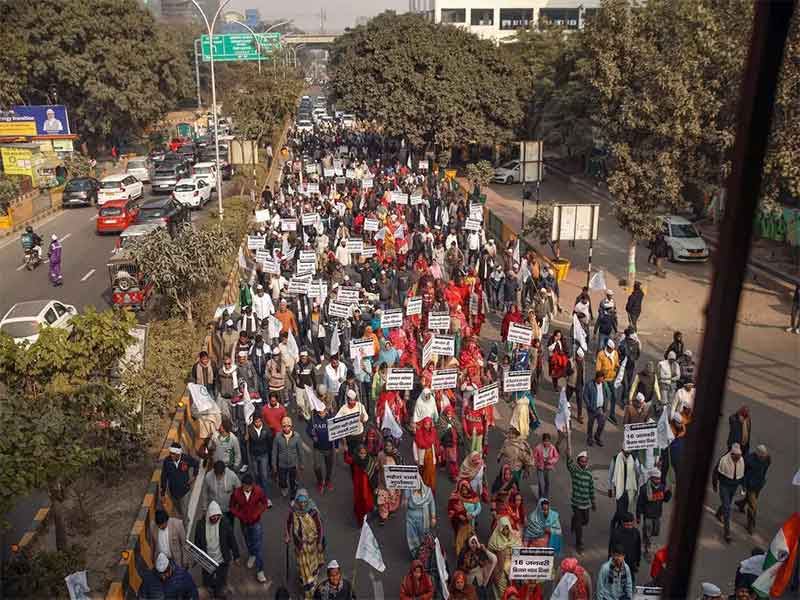
While the farmers continue to hold demonstrations near the national capital against the recently-enacted Farm Laws that have facilitated the entry of big corporate players in the agricultural sector, several Hindi newspapers are busy demonizing the movement and linking it to the Khalistani terrorists.
Several narratives are being constructed by the media to portray the Farmers’ Protests as unruly, violent, causing inconveniences to the common people. Worse still, the movement is being seen as the result of the “narrow political interests”. The agencies of the farmers have been withdrawn and they are being shown as the mere puppets in the hands of the “selfish” political parties. A leading national daily has gone to the extent of showing the link between the farmers’ protests and the Khalistani terrorists and has claimed that a conspiracy is being hatched to create violence.
In other words, if one goes by such malifecent and malacious propaganda, the legitimate demands of the farmers and the crisis in the agricultural sector constitute a law and order problem. The coverage of the media is yet another pointer to the fact that serving the corporate interests and big businesses is its only and utmost priority.
The farmers as well as the opposition leaders have been opposing the Farm Bills – the Farmers’ Produce Trade and Commerce (Promotion and Facilitation) Bill, 2020, the Farmers’ (Empowerment and Protection) Agreement of Price and the Assurance and Farm Services Bill, 2020. However, the route to deliberation and consultation was not taken up and the Bills were declared passed by a voice vote. Afterwards, eight of the protesting opposition members were suspended, accusing them of creating a ‘ruckus’ in the Parliament.
Instead of analyzing the matter properly, the mainstream media, particularly the Hindi press, has not only largely ignored the concerns of the opposition parties, but has also toed the government’s line. Worse still, it has also tried to delegitimize the opposition by calling them unruly and has downplayed the farmers’ agitations.
In this regard, by now, it is much more that just merely being self-evident that the media is notoriously and shamelessly complicit in foregrounding and championing the corporate agenda. And, in doing this, they can go to any extent. For example, when the Farmers March began to move towards Delhi, Punjab Kesari preached to the farmers that holding such a protest amid the corona pandemic is unjustified. Writing a page-one editorial, Aditya Narayan Chopra (Punjab Kesari, Delhi, November 26) asked the farmers to maintain restrain: “The farmers’ organizations should show restraint. Prime Minister Narendra Modi is showing the benefits of the Farm Laws from every platform. Only those movements are better which are disciplined and the ones which do not harm others and other states. Amid Corona pandemic, their march to Delhi is not justified”. Note that the writer has expressed several concerns other than those of the farmers. Also ironical is his advice not to hold gathering amid the corona pandemic. Did he express such cautionary advice when the Prime Minister himself led a gathering to perform a ground-breaking ceremony (bhoomipoojan) in Ayodhya a couple of months ago? Did he also ask the BJP leaders not to hold victory processions after their electoral victory? One would like to know.
The editorial of Dainik Jagran (National, November 28) titled “misplaced protest” (beja virodh)”, serves the interests of the big corporate players and the government at the cost of the farmers’ concerns. It weaved a new conspiracy theory that the farmers have been instigated and misled by the narrow political interests (sankirn rajnitik swarth). It went on to link it to Shaheen Bagh protests which were, according to the editorial, the handiwork of selfish political interests. The daily, while supporting the Farm Bills, was dismissive of the farmers’ concerns. It also claimed that the farmers across the county had no problem with the Farm Laws. It had so much faith in the government that any opposition to it was misplaced. The editorial said that protests led by the farmers could not be legitimate when the government was willing to hold talks with them.
For a couple of days, the pages of the newspapers were filled with the stories and pictures, showing the traffic jams and inconvenience suffered by the so-called illusory ‘common people’. “Farmers created harassment”–Dainik Jagran (National, Nov 27) ran a headline. It also claimed that the people who were coming for the medical treatment also suffered. The details about how the metro services got affected and how the protests caused traffic jams were given. Similarly, Pioneer (Hindi, Delhi, Nov 27), published a four-column story (p. 4) with the following headline “Big traffic jam due to Farmers movement”. On the next page, it also printed another story of a traffic jam. The four-column story also had a picture showing several cars stuck in a jam.
Giving the details about how farmers’ protests were causing inconvenience to people, Dainik Jagran (National, November 28), wrote that people were stuck in a traffic jam for hours; the metro services were also affected; the supply of essential goods was affected. The coverage ended up blaming the farmers for resorting to violence, who pelting stone and used batons (lathi). However, it whispered almost nothing (in fact with the purpose of hiding it) about the high-handedness of the police. On the contrary, nevertheless, several viral videos show as to how the security forces have been consistently and brutally using batons, water cannons and tear gas against the peaceful protestors. These forces are so hell-bent that they are not sparing even the old-aged farmers. Hindustan, too, showed no willingness to listen to the farmers. On its first page, the daily (Delhi, November 29) reduced the whole movement to a law and order problem with the following headline: “Disturbance caused by the farmers in the UP Gate”.
Apart from showing how the farmers’ protests are unruly and causing disturbances to the so-called illusory ‘common people’, an attempt was also being made to link the peaceful protests to the Khalistani terrorists. During the Punjab agitations in the 1980s, the Indian establishment and the mainstream media laid all blame on the alleged Khalistani terrorists for destabilizing the country. But the fact of the matter is that the Indian establishment itself constructed the image of Khalistani terrorists purportedly supported by the anti-India forces, in order to externalize the internal crisis. The Punjab crisis has much to do with unequal state-central relations and the narratives of the Khalistani terrorists were created to hide the root cause of the problem. Similarly, the Khalistani terrorists are being invoked to delegitimize the genuine concerns of the farmers.
On November 29, Dainik Jagran published a story entitled “Law and order situation may be disturbed by Khalistani Terrorists and anti-social elements (Mahaul bigad sakte hain Khalistani Aatanki aur Asamajik Tatv). The story went on to scare the readers about the farmers’ protests in the following words: “Anti-farm laws protests led by the farmers may take a violent turn. Khalistani terrorists and anti-social elements are trying to create disturbances (gadbadi) in the movement as the inputs from the intelligence agencies are to go by. In the wake of such development, the police remain alert. The Special Cell forces wearing plain-clothes are keeping an eye on the protestors who have gathered around (Haryana-Delhi) border and Nirankari Samagam Ground, Burari. According to the police sources, the intelligence agencies have received input that Khalistani terrorists are conspiring to create violence by exploiting the situation. The Special Cell of the Delhi Police has also recorded the conversation of the Khalistani terrorists. Their motive is to spread violence”.

The media in a democratic country has a big responsibility of presenting the views of all the stakeholders and initiating a dialogue to reach an agreement to the satisfaction of all. But the mainstream media, particularly the Hindi press, abandoned its task. Instead, it is working as the spokesperson of the big capital and the government. To serve the interests of those who are in power and the ones who are their investors and advertisers, the media is stooping further low and resorting to unfair means. Instead of paying attention to the aggrieved parties, it is unethically indulging in demonizing and discrediting them. That is why it has no qualm in linking the peaceful protestor to so-called Khalistani terrorists.
(Abhay Kumar is a Ph.D. from JNU. He is broadly interested in Minority and Social Justice. Earlier, he held a Post-Graduate Diploma in English Journalism from the Indian Institute of Mass Communication, New Delhi, and worked as a Delhi-based reporter with The Indian Express. You may write to him at [email protected]).
SIGN UP FOR COUNTERCURRENTS DAILY NEWSLETTER














































